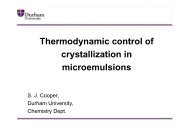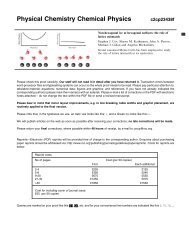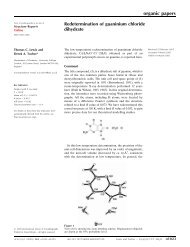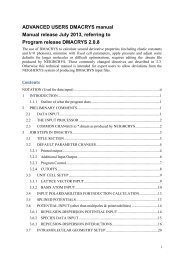An Introduction to the Theory of Crystalline Elemental Solids and ...
An Introduction to the Theory of Crystalline Elemental Solids and ...
An Introduction to the Theory of Crystalline Elemental Solids and ...
You also want an ePaper? Increase the reach of your titles
YUMPU automatically turns print PDFs into web optimized ePapers that Google loves.
34<br />
TABLE 4: Theoretical (DFT LDA <strong>and</strong> PBE) <strong>and</strong> experimental surface energies in meV/Å 2 for<br />
some close-packed transition metal surfaces. All data is taken from ref. [57] except for <strong>the</strong> Pb<br />
results which are from ref. [127].<br />
Mg(0001) Al(111) Ti(0001) Cu(111) Pd(111) Pt(111) Pb(111)<br />
LDA 38.7 56.8 141.7 119.8 116.7 139.2 26.0<br />
PBE 35.0 46.8 124.2 88.0 83.0 104.2 17.2<br />
Exp. 49.3 71.2 124.2 114.2 125.5 155.4 27.5<br />
<strong>the</strong> exchange-correlation contribution <strong>to</strong> <strong>the</strong> surface energy is calculated more reliably<br />
with <strong>the</strong> LDA due <strong>to</strong> a favorable cancelation <strong>of</strong> errors: LDA overestimates <strong>the</strong> exchange<br />
contribution <strong>to</strong> <strong>the</strong> surface energy, but underestimates <strong>the</strong> correlation contribution,<br />
whereas PBE underestimates both quantities [36, 130, 131]. Since <strong>the</strong>se results on jellium<br />
surfaces are apparently transferable <strong>to</strong> real metals, it is reasonable <strong>to</strong> anticipate that<br />
functionals which are superior <strong>to</strong> LDA for jellium surfaces will also be superior <strong>to</strong> LDA for<br />
real metal surfaces. In this regard it appears that <strong>the</strong> meta-GGA TPSS, PBE-WC, <strong>and</strong> a<br />
functional from Mattsson <strong>and</strong> co-workers based on a subsystem functional approach <strong>of</strong>fer<br />
some promise [32, 131, 132]. However, whe<strong>the</strong>r <strong>the</strong>se functionals live up <strong>to</strong> expectations<br />
for real metal surfaces <strong>and</strong> solid surfaces in general remains <strong>to</strong> be seen.<br />
6.3 Phenomenological Theories <strong>of</strong> Surface Energies<br />
So far we have not discussed <strong>the</strong> physics <strong>of</strong> <strong>the</strong> surface energy. Why do different materials<br />
exhibit different surface energies? Why does <strong>the</strong> surface energy <strong>of</strong> different facets <strong>of</strong> <strong>the</strong><br />
same material differ? Essentially both questions are <strong>the</strong> same as asking: what controls<br />
<strong>the</strong> magnitude <strong>of</strong> <strong>the</strong> surface energy? The qualitative answer <strong>to</strong> this is very simple:<br />
<strong>the</strong> surface energy is related <strong>to</strong> <strong>the</strong> number <strong>and</strong> strength <strong>of</strong> <strong>the</strong> bonds which are broken<br />
in creating <strong>the</strong> surface. Thus surface energies exhibit similar periodic dependencies as<br />
cohesive energies do, <strong>and</strong> surface energies are lower for more closely packed surfaces than<br />
<strong>the</strong>y are for <strong>the</strong> more open ones or with less dangling unsaturated bonds.<br />
(a) Surface energies <strong>and</strong> cohesive energies<br />
For any given element its surface energy is a fraction <strong>of</strong> its cohesive energy. Most <strong>of</strong>ten<br />
it turns out that for metals G S per surface a<strong>to</strong>m ∼ 1/6E coh per bulk a<strong>to</strong>m [133]. This<br />
rough empirical relationship can be seen in Fig. 17(a), for example, where <strong>the</strong> ratio <strong>of</strong><br />
experimental heat <strong>of</strong> vaporization <strong>and</strong> experimental surface energy is plotted for more<br />
than 20 metals. Correlations like this have a long his<strong>to</strong>ry <strong>and</strong> can easily be refined <strong>to</strong><br />
account for <strong>the</strong> elements which are outliers on <strong>the</strong> plot [134].<br />
So where does <strong>the</strong> value <strong>of</strong> <strong>the</strong> proportionality constant come from? Simply counting <strong>the</strong><br />
number <strong>of</strong> nearest-neighbor bonds that break in making a close-packed surface would lead<br />
one <strong>to</strong> expect a value <strong>of</strong> 1/4 or larger, since at <strong>the</strong> most closely packed (111) surface <strong>of</strong><br />
an fcc metal 1/4 <strong>of</strong> <strong>the</strong> bonds are broken. On less closely packed surfaces obviously more<br />
bonds are broken. As discussed by Methfessel et al. [136, 139] <strong>the</strong> reason <strong>the</strong> simple bond<br />
cutting model fails <strong>to</strong> predict <strong>the</strong> correct proportionality constant is that it neglects <strong>to</strong><br />
account for <strong>the</strong> variation <strong>of</strong> <strong>the</strong> bond strength with coordination number, C. In particular







